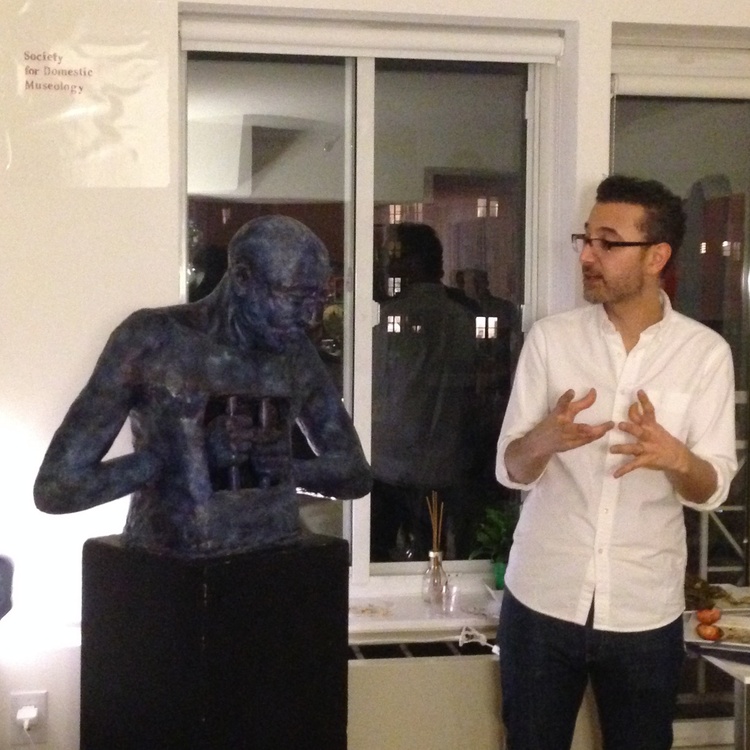In early February, I had the great pleasure of attending an opening at yet another new chapter of the Society for Domestic Museology. Our friends Joe and Sundus invited Saks Afridi and Quinza Najm, who comprise the artistic duo BOLO (Urdu for "speak up"), to show some of their collaborative work. Featuring four large paintings from a series called Frontiers and a hauntingly powerful sculpture, the show -- and the dramatically transformed apartment setting -- made for the most gallery-like Domestic Museology opening yet.
National Geographic defines a map as a "symbolic representation of selected characteristics of a place, usually drawn on a flat surface." On the most basic level, maps help us understand and navigate space, getting us from one place to another. The language of roads and borders give order and structure to unfamiliar territory. By design, a map's aerial viewpoint requires a certain detachment to be understood, even when you're consulting it to locate where you are and where you're headed. Yet, for all the authority we attribute to maps, what they tell us is largely ephemeral and depends on your point of view. In other words, everyone reads a map a little differently -- particularly maps of territories in dispute.
These are some of the ideas at play in the four paintings BOLO hung on Sundus and Joe's walls -- three side-by-side on the living room wall with the fourth just around the corner in the entry. Each painting represented a different politically disputed location: Cuba's Guantanamo Bay; Anuchal Pradesh, along the India-China border; the Golan Heights and the West Bank. Using images from Google Maps as a starting point, Ms. Najm and Mr. Afridi render great swathes of land in shadings of grey and black alongside vibrant reds and yellows on canvas and wood, creating geometric abstractions that are appropriately reminiscent of national flags. In a sense, the two undertake their own collaborative mapping process that explores the inherent folly of attempting to impose rigidly defined borders on areas with complex and ambiguous histories (indeed, the natural border formed by the rectangular edge of one painting is violated by jagged corners of territory jutting into the space beyond the frame). Through the constant dialogue and compromise required by the process of collaboration, the artists are, in effect, creating and dismantling the borders of individual artistic identity. And they challenge observers to reconsider the authority we bestow upon maps.
Though not a part of the Frontiers series, the sculpture, by Mr. Afridi, provided a fitting counterpoint to the paintings. Inspired by a drawing by the cartoonist Amjad Rasmi, the sculpture depicts the bust of a man with a hollow torso and prison bars where his chest should be. His hands reach in through the sides of his torso and clutch the bars at his chest. In contrast to the global disputes and identity politics playing out in the large-scale paintings, the sculpture evokes a more intimate, psychological (yet no less political) struggle playing out on the human form.
This was big art, both in size and concept, and yet the domestic setting succeeded in accommodating the scale. Sundus and Joe moved into the Hamilton Heights apartment a year ago with their 9-year-old daughter, and they've created an elegant and versatile space that needed only a few small modifications in order to transform it from a cozy home into a gallery. The anchor was the modern white leather sofa, which had been unfolded and opened flat to provide a museum-style bench seat in the middle of the living, perfect for viewing the large paintings on the wall. In the adjacent bedroom, all evidence of sleeping space had been folded up into the wall to create another lovely seating area that featured images from the artists' website. In our apartment, we generally asks artists to install work that integrates into our domestic space; here, the apartment rose to the occasion of the work.
As I've found with all Domestic Museology exhibitions, this one was all the more compelling when considered in the context of its domestic venue. By bringing the outside in (the paintings) and the inside out (the sculpture), the works disrupt the comfort of home by confronting its inhabitants with the kinds of difficult questions one often wants to take refuge from at home. On the other hand, maybe it is the safety of the domestic space where all of these things can be unravelled and explored.
I'm looking forward to seeing more work by these two artists, both Pakistani-American, who are dealing with issues of identity, nationality and psychology in such visually compelling ways. You can see more of their work here:
http://www.bolo-art.com/
http://qinzanajm.com/
http://www.saksafridi.com/

